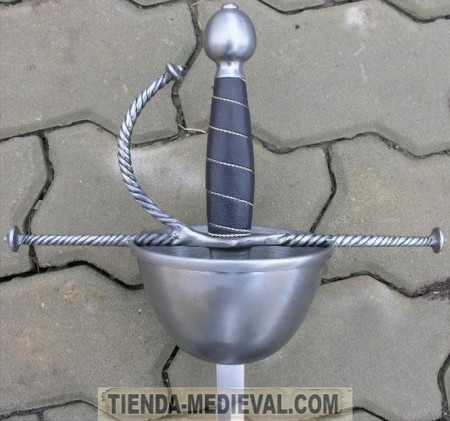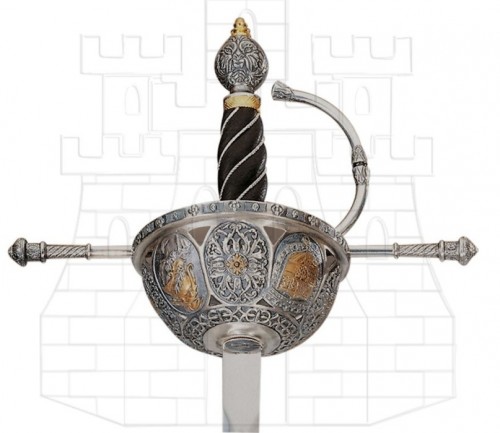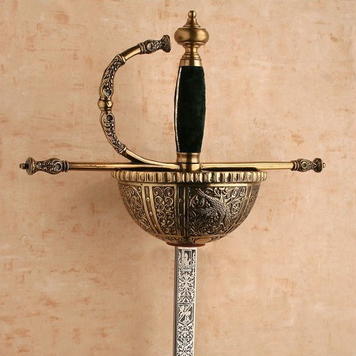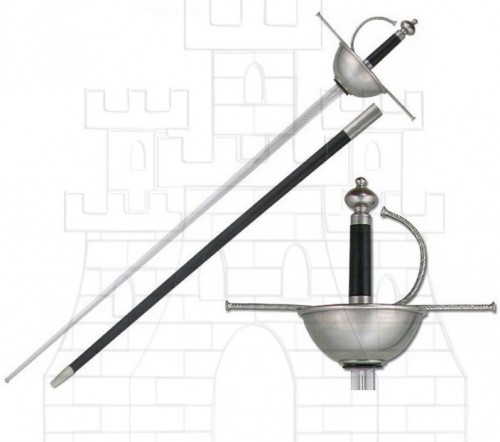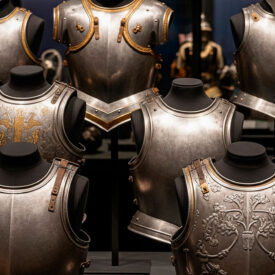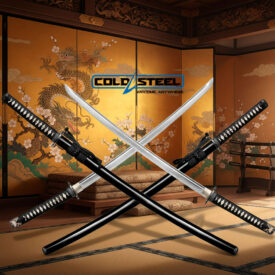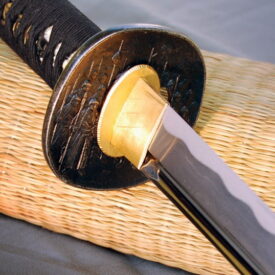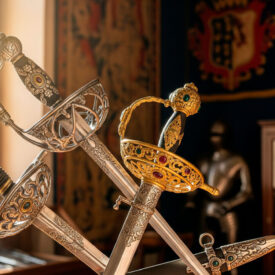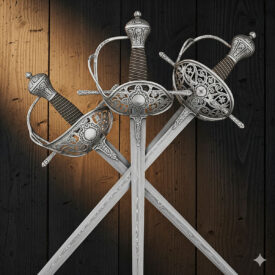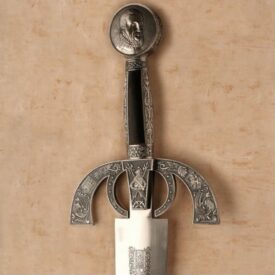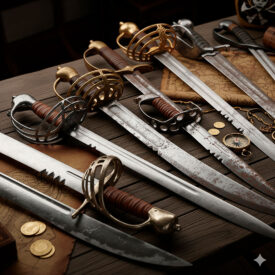What does a cazoleta evoke when you hold it up to the sun? Imagine the Spanish countryside of the Golden Age: capes brushing the cobblestones, trades hardened by steel, and a whisper of honor resolved with a precise thrust. That condensed image is the promise of the cazoleta sword, a piece that was at once a tool of defense, a declaration of status, and an artisanal masterpiece.

In this journey, you will learn to distinguish an authentic cazoleta, understand its anatomy and its use in Spanish historical fencing, see its chronological evolution, and discover the regional differences that made it emblematic. We also provide images and historical links so you can see replicas and representative examples.
A quick look at its chronology
Before delving deeper, it’s worth placing the cazoleta in time: its visual and documentary imprint is especially notable between the early 17th and early 18th centuries. The chronology helps to understand why this hilt was so strongly associated with Spanish courtly identity.
| Date / Period | Event / Description |
|---|---|
| Late 16th century (theoretical) | Some theories and authors (e.g., Leguina) suggest appearances in the late 16th century and even cite 1552; however, these early dates have not been confirmed in portraits. |
| First third of the 17th century | Main development of the cup-hilt sword: emergence and consolidation of the type. |
| 1628–1629 | First confirmed pictorial representation: portrait of Philip IV attributed to Diego de Velázquez. From this date, its presence in civil portraits is common. |
| 1639 | First documented appearance in fencing treatises (treatise by Luis Díaz de Viedma). |
| c.1660 | Early examples of smallswords (French type) — beginning of the coexistence and the process that would lead to the progressive replacement of the cazoleta by the smallsword. |
| 17th century (heyday) | Maximum splendor and widespread use, especially in territories under Spanish Crown influence. In the 17th century, shell and then cup hilts were referred to as “Spanish.” |
| Comparative characteristics | Spanish cups are distinguished by being less deep, smaller in diameter, and having a smaller pommel than Italian ones; they frequently include a dust guard and a point breaker. Their documented use is mainly civil (they do not appear in military representations). |
| c.1700 | Last known pictorial reference: portrait of Philip V by Juan García de Miranda (around 1700). |
| Until 1731 | Last documented appearance in fencing treatises (treatise by Nicolas Rodrigo Noveli, 1731). The period of visual and documentary existence of the typology is approximately between 1628 and 1731, just over a century. |
| Early 18th century | Decline and progressive replacement by the French-origin smallsword, which became more frequent with French influence in the Iberian Peninsula after the accession of Philip V. |
Origin and expansion: why did the cazoleta emerge?
The cazoleta was born out of a functional need transformed into a social fashion. As fencing favored thrusting over cutting, hand protection became a priority. The solution was a metallic cup that covered the back of the hand without adding excessive weight: the cazoleta.
At the same time, the sword ceased to be merely a weapon of war and became an element of civility and distinction. Wearing a rapier at the belt was a mark of social standing; that is why its style and ornamentation became as important as its effectiveness.
Elements that define a cazoleta sword
The anatomy of the cazoleta combines defense, balance, and design. Here are the key components:
- Cazoleta (cup): Hemispherical cap covering the back of the hand. It can be smooth, chiseled, or pierced, and often features a point-breaker to trap the enemy blade.
- Quillons and knucklebow: Long rods that reinforce the connection between the cazoleta and the body of the sword, contributing to lateral protection.
- Blade: Straight, narrow, and sharp point prepared for thrusting. Common lengths range from 90 to 110 cm in historical examples.
- Grip: Short and adapted to the Spanish technique that favored resting some fingers on the blade for precise control.
- Pommel: Counterweight that stabilizes; in Spanish cups, it is usually smaller than in Italian ones.
These design decisions were not arbitrary: they responded to the geometry of fencing technique and to considerations of fashion and status.
The cazoleta in detail: point breakers, dust guards, and finishes
The point-breaker is a characteristic defensive detail: a rim on the edge of the cazoleta that allows catching or deflecting the opponent’s point. The inner dust guard, when present, also protected the hand from dirt and moisture.
Finishes: Cazoletas could feature engravings, damascening, fine openwork, or gilded and silvered coatings. These decorations elevated the piece to an object of goldsmithing.
Replicas and related swords
For those interested in replicas or in exploring Renaissance and rapier models, there are historical categories that group functional and decorative versions. Below we show representative products through a catalog selector.
Manufacture and historical centers: where the cazoleta was born
The cazoleta was forged in centers with a tradition in steelwork: Toledo, Valencia, Biscay, Zaragoza, and Barcelona stand out for their participation in the production chain. Each region imprinted its own characteristics on the blades and hilts.
Toledo contributed tradition and renowned tempering; Valencia, fine blades and courtly hilts; Biscay supplied materials and an excellent tempering tradition; Zaragoza and Barcelona brought decorative details and complex hilts.
Forging techniques and finishes
Manufacturing combined forging, differential tempering, and ornamental finishing. Two metals were often used to achieve a blade with a flexible core and a resistant surface. Tempering was an art and, at times, a secret kept by family workshops.
The grips were covered with metal threads, silk, or leather. Damascening and chiseling transformed many rapiers into pieces that rivaled jewelry in complexity and aesthetics.
The fencing that created the cazoleta: the True Skill (Verdadera Destreza)
It is not possible to talk about cazoleta swords without mentioning the Spanish school of fencing: the Verdadera Destreza. Jerónimo Sánchez de Carranza and Luis Pacheco de Narváez systematized a technique based on geometry, distance, and economy of movement.
- Stance: Right angle with the armed arm extended to maximize reach and control.
- Movement: Circles and lines projected onto the imaginary ground to maintain positional advantage.
- Thrusting priority: The point triumphed over the cut; this is why blades narrowed and cazoletas became prevalent.
In civil combat, the sword-dagger combination was common: the defensive cut of the dagger complemented the precise thrust of the rapier, and the cazoleta protected the hand in blade crossings.
Maneuverability and balance
A well-made cazoleta has a balance point close to the hilt (approximately 6.5–7.5 cm from the guard). This balance allows for fluid movements with the point and complex maneuvers without fatiguing the forearm.
The short grip, common in Spanish examples, facilitated fine control and partial resting of the fingers on the ricasso of the blade to adjust the trajectory of the thrust.
Comparison: Spanish cazoleta vs. other European variants
Although the cazoleta spread throughout Italy and other regions, the variants show aesthetic and functional differences that are worth knowing.
| Feature | Spanish | Italian / French |
|---|---|---|
| Cazoleta depth | Less deep; reduced diameter | Deeper and larger diameter |
| Pommel | Smaller pommel | Larger pommel for greater counterweight |
| Decoration | Damascening, fine openwork, point-breaker | Frequent Renaissance and Baroque ornamentation, sometimes more exuberant |
| Use | Mainly civil and courtly | Civil and, in some cases, militarized |
| Balance | Closer to the hilt for fine fencing | Can shift the balance point towards the blade or pommel depending on design |
This table summarizes general features; within each tradition, there was diversity and overlap. The typology evolved in relation to combat styles and local fashions.
Social use, regulation, and symbolism
Wearing a cazoleta meant more than just protection. It was about displaying status, belonging to a code of honor, and participating in a social ritual that included the cape, the hat, and the sword at the belt. Due to duels, authorities imposed limits on blade length and the dangerousness of points.
These regulations sought to reduce violence in the streets and control who could carry weapons that were too lethal in civilian hands. Even so, the sword retained its symbolic prestige.
Maintenance and preservation (for collectors and historical practitioners)
Preserving a cazoleta involves caring for the blade and preserving the decorative cazoleta: regular cleaning, humidity control, and repairs to the grip or wrapping. Avoid aggressive polishing of historical decorations; patina can be a valuable part of the piece’s character.
In modern functional replicas, more homogeneous steels and treatments are used that improve durability without sacrificing classical aesthetics.
VIEW CUP-HILT RAPIERS | VIEW RENAISSANCE SWORDS
The cazoleta sword endures as a symbol and as an object of study. It not only tells us about combat techniques, but also about tastes, crafts, and power systems. Holding a rapier, even a replica, is touching a custom that one day defined the bearing of a gentleman.
If you explore its chronology and anatomy, you will understand that the cazoleta is not an isolated curiosity: it is the material response to a cultural and technical transformation. It is the perfect alliance between functionality and beauty that makes a tool of defense become a legend.
